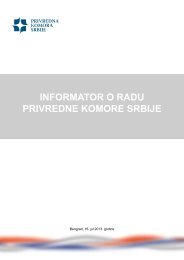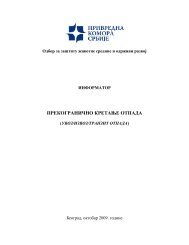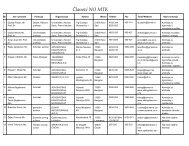- Page 2 and 3:
PERSPEKTIVA UGLJA KAO ENERGENTA THE
- Page 4 and 5:
Slika 3: Istorijska (1995-2000) i p
- Page 6 and 7:
konzuma biti 1,15% (napomena autora
- Page 8 and 9:
5. CENE UGLJA NA ENERGETSKIM TRŢI
- Page 10 and 11:
RAZVOJ RUDARSKOG KOMPLEKSA VELIKI K
- Page 12 and 13:
Površinski delovi su oksidisani (3
- Page 14 and 15:
50 200 2.2. Rudnik bakra Veliki Kri
- Page 16 and 17:
Zbog potrebne veće koliĉine konce
- Page 18 and 19:
PERSPEKTIVE RAZVOJA RUDNIKA BAKRA M
- Page 20 and 21:
2009. 2.372.510 7.792.510 5.882 473
- Page 22 and 23:
Stari Dušan Ruda (t) Cu% Cu (t) Au
- Page 24 and 25:
Rudno telo Ruda (t) Cu% Cu (t) Geol
- Page 26 and 27:
Rezime ODRŢAVANJE RUDARSKE OPREME
- Page 28 and 29:
Rotorni bager (reĊe se u tu svrhu
- Page 30 and 31:
površinskim kopovima, tj. već od
- Page 32 and 33:
(pouzdanosti, gotovosti i pogodnost
- Page 34 and 35:
Svaka kompanija definiše i analizi
- Page 36 and 37:
Troškovi odrţavanja opreme prote
- Page 38 and 39:
„praktiĉnog― odrţavanja rudar
- Page 40 and 41:
Tabela 1. Rekapitulacija geoloških
- Page 42 and 43:
dovoljno da se savlada materijal se
- Page 44 and 45:
Tehnološki proces eksploatacije Za
- Page 46 and 47:
Normativi materijala. Normativi mat
- Page 48 and 49:
strukturno izuĉavanje leţišta ka
- Page 50 and 51:
eksploatišemo i pripremamo duţi n
- Page 52 and 53:
2.1. Rudarski kompleks 2.1.1. Rudni
- Page 54 and 55:
Na slici 7., dat je poloţaj objeka
- Page 56 and 57:
podrazumeva više aktivnih otkopnih
- Page 58 and 59:
izradom Glavnog servisnog niskopa (
- Page 60 and 61:
Ukupna koliĉina raspoloţive rude
- Page 62 and 63:
a) Specifiĉna potrošnja reagenasa
- Page 64 and 65:
odvijati u pogonu flotacije Veliki
- Page 66 and 67:
-Koncepcija zgušnjavanja i hidrotr
- Page 68 and 69:
Da se rekonstrukcija postojećih te
- Page 70 and 71:
PRIMENA ZAKONA O RUDARSTVU I GEOLO
- Page 72 and 73:
u proces proizvodnje celokupnog otp
- Page 74 and 75:
ODRŢIVO UPRAVLJANJE JALOVINOM U RU
- Page 76 and 77:
- uvodi dvostepeni sistem za prevoz
- Page 78 and 79:
porast sistemskog korišćenja ener
- Page 80 and 81:
NATURAL STONE EXCAVATION PROCESS AN
- Page 82 and 83:
The Fantini G.70 chain saw cutting
- Page 84 and 85:
their sites, their excavation prefe
- Page 86 and 87:
elacija meĊu njima dok delikatnost
- Page 88 and 89:
3. Karakteristike rudarske delatnos
- Page 90 and 91:
MINERALNE NAKNADE - ZABLUDE I POSLE
- Page 92 and 93:
- Sve ove zemlje imaju vrlo razvije
- Page 94 and 95:
predloţeno da se mineralna renta s
- Page 96 and 97:
Izvod MOGUĆNOST DEPONOVANJA PEPELA
- Page 98 and 99:
SITUACIJA TRASA CEVOVODA ZA HIDROTR
- Page 100 and 101:
ANALIZA GEOLOŠKE ISTRAŢENOSTI RUD
- Page 102 and 103:
Tabela 2 Izabrana leţišta sa rudn
- Page 104 and 105:
B+C G Veliki Crljeni Sopic- Lazarev
- Page 106 and 107:
B+C G Veliki Crljeni Sopic- Lazarev
- Page 108 and 109:
eći sa 1.1 €cent/t). Saglasno na
- Page 110 and 111:
Southern limit of the Zagorsko - La
- Page 112 and 113:
detained and later was adopted and
- Page 114 and 115:
examine the remaining reserves in t
- Page 116 and 117:
vrijednosti (na bazi postojećih an
- Page 118 and 119:
8 - 8,5 24,2 13,8 8,5 - 9 13,8 27,6
- Page 120 and 121:
TakoĊe, u geološkom stubu ugljeno
- Page 122 and 123:
IZMJEŠTANJE DIJELA KORITA RIJEKE G
- Page 124 and 125:
Slika 1. Šematski prikaz izrade os
- Page 126 and 127:
Na fotografijama su priazane faze i
- Page 128 and 129:
ANALIZA RADA SISTEMA ZA TRANSPORT U
- Page 130 and 131:
Proizvodni kapacitet kopa iznosio j
- Page 132 and 133:
3.2. TEHNOLOGIJA RADA PRIMIJENJENOG
- Page 134 and 135:
Sati 10000 9000 8000 7000 6000 5000
- Page 136 and 137:
TEHNIĈKO -TEHNOLOŠKO REŠENJE UPR
- Page 138 and 139:
tok uglja Geolo{ki model le`i{ta MO
- Page 140 and 141:
Voz broj 423 Broj vagona 27 Koliĉi
- Page 142 and 143:
OCENA RIZIKA I NESIGURNOSTI U ZAŠT
- Page 144 and 145:
Koncept upravljanja rizikom se defi
- Page 146 and 147:
Tabela br. 2: Mesta nastanka otpadn
- Page 148 and 149:
U smislu usaglašenosti, poštovanj
- Page 150 and 151:
Zakljuĉak Ocena stanja ţivotne sr
- Page 152 and 153:
PRIMENA MODELA: HEMIJSKI LIZING NA
- Page 154 and 155:
Slika 5.- Pogonska stanica sa kosim
- Page 156 and 157:
Definisanje modela (definisanje jed
- Page 158 and 159:
Princip dejstva transportera sa pri
- Page 160 and 161:
kome se vrši dodatno drobljenje u
- Page 162 and 163:
(kamioni-ţeleznice-trake...). Duţ
- Page 164 and 165:
Uicaj kamionskog transporta. Štetn
- Page 166 and 167:
Opšti problem višekriterijumskog
- Page 168 and 169:
RAZVOJ ODRŢAVANJA POMOĆNE MEHANIZ
- Page 170 and 171:
Tabela 1. Klasifikacija procesa, ra
- Page 172 and 173:
.br Vrsta mašine Br. kom Vrsta ma
- Page 174 and 175:
DINAMIKA SERVISIRANJA I OPRAVKI MA
- Page 176 and 177:
R. Br. 2. Odredjivanje broja izradj
- Page 178 and 179:
REKAPITULACIJA POTREBNE RADNE SNAGE
- Page 180 and 181:
NEKI PROBLEMI TOKOM ZATVARNJA OTVOR
- Page 182 and 183:
Sitan lomljeni kamen ø 80 - 150 mm
- Page 184 and 185:
muljeve ograĊivao kamen krupnoće
- Page 186 and 187:
d) UKLJUĈENJE BAGERA DREGLAJNA U S
- Page 188 and 189:
Postoji velika razlika u kvalitetu
- Page 190 and 191:
1.3 Rudnik Nova Manasija - Zatvoren
- Page 192 and 193:
3.3 Rudnik Nova Manasija Tehnološk
- Page 194 and 195:
sl. br.1 Pregledna karta kolubarsko
- Page 196 and 197:
Plan rada Ia BTO sistema Na etaţi
- Page 198 and 199:
Plan rada BTS sistema Na etaţi BTS
- Page 200 and 201:
45000 45000 45000 45000 ? ?? ?? ??
- Page 202 and 203:
Tabela 1. Poĉetak i kraj rada BTO
- Page 204 and 205:
Slika 2. Konture rasprostiranja pod
- Page 206 and 207:
557,00 554,00 547,00 544,00 537,00
- Page 208 and 209:
Linija fronta ugljene etaţe stiţe
- Page 210 and 211:
znaĉajnijih aktivnosti. Dalje akti
- Page 212 and 213:
- gustine - temperature - brzine ve
- Page 214 and 215:
Slika 9. Model stepena doziranja te
- Page 216 and 217:
sistematskih istraţivanja u 1960.
- Page 218 and 219:
srednjezrn do sitnozrn bela G O R N
- Page 220 and 221:
Slika br. 1 Geološki stub dela le
- Page 222 and 223:
oblikovanja formirane su i naborne
- Page 224 and 225:
POVRATAK NA STARU LOKACIJU ODLAGALI
- Page 226 and 227:
1957 1958 1959 1960 1961 1962 1963
- Page 228 and 229:
225 Otkrivka iz prve faze odlaţe s
- Page 230 and 231:
?.5 1.5 ?.2 2.5 O-V ? .5 M6 ?.18 ?.
- Page 232 and 233:
ZATVARANJE RUDNIKA LIGNITA „BUKIN
- Page 234 and 235:
5. OBRAZLOŢENJE POTREBE ZATVARANJA
- Page 236 and 237:
a) Likvidacija otkopnog polja Otkop
- Page 238 and 239:
e) Prenamjena rudniĉkog ambijenta
- Page 240 and 241:
na neku konstantnu vrednost. To nij
- Page 242 and 243:
- Vaţnije rasede, pukotine, ponore
- Page 244 and 245:
trţište grejanja. U nemaĉkom rud
- Page 246 and 247:
Slika 5: Poloţaj Nordhausen-a u Ne
- Page 248 and 249:
Troškovi i vremenski rokovi koji s
- Page 250 and 251:
Osnovni nivo Osnovni nivo Slika 6:
- Page 252 and 253:
Tabela 2: Troškovi bušenja na jed
- Page 254 and 255:
UOPŠTENO O DUBLJENJU OKNA ZA HIDRO
- Page 256 and 257:
IZRADA POMOĆNOG OKNA USKOPNOM PLAT
- Page 258 and 259:
Slika 8: Fotografija radilišta na
- Page 260 and 261: Slika 9: Poprečni presek prilaznog
- Page 262 and 263: LITERATURA 1. Rudarski projekt za i
- Page 264 and 265: N slika1. Pregledna geografska kart
- Page 266 and 267: 4.0. TEHNOLOGIJA OTKOPAVANJA OTKRIV
- Page 268 and 269: Odlaganje kvartarnih glina Tabela b
- Page 270 and 271: TEHNIĈKE KARAKTERISTIKE ODLAGAĈA
- Page 272 and 273: Kamenolom ''Nepri~ava'' (kre~njak)
- Page 274 and 275: ALUGA 114.0 1 0 98.8 1 0 693 2 730
- Page 276 and 277: c) Izdan u peskovima gornjeg ponta.
- Page 278 and 279: REKA KOLUBARA F AZA P.S 107.5 105 9
- Page 280 and 281: KORELACONE VEZE MEĐU POJAVAMA KOLI
- Page 282 and 283: 2,100 1,900 1,700 1,500 1,300 rasip
- Page 284 and 285: Za 1,095 (kolona 8): (1,095 - 1,447
- Page 286 and 287: X Y X 2 Y 2 x x y y 2 x x y
- Page 288 and 289: 10. Zakljuĉak Na osnovu ispitivanj
- Page 290 and 291: flore i faune na mestu odlaganja, b
- Page 292 and 293: Slika 1. Geomorfološka mapa kostol
- Page 294 and 295: Klaster 1 (n=3) Klaster 2 (n=6) Kla
- Page 296 and 297: najkvalitetnijih sojeva za komercij
- Page 298 and 299: FITOREMEDIJACIJA TEŠKIH METALA IZ
- Page 300 and 301: Današnja tehnologija osnivanja zas
- Page 302 and 303: POLJOPRIVREDNA PROIZVODNJA NA DEPOS
- Page 304 and 305: Slika 2. Prirodno zemljište je pot
- Page 306 and 307: hemijskih analiza treba istaći ned
- Page 308 and 309: Slika 7 Što se tiĉe "Voćarske" p
- Page 312 and 313: procedure takes into account the co
- Page 314 and 315: The denominator in equation (17) is
- Page 316 and 317: Accuracy comparison of the observat
- Page 318 and 319: Number of valid observations [%] Š
- Page 320 and 321: ANALIZA PRIRODNO-GEOLOŠKIH USLOVA
- Page 322 and 323: Za pripremne rudarske prostorije, k
- Page 324 and 325: Tabela 2. Overene rezerve uglja u n
- Page 326 and 327: ANALIZA PROMENE HIDROGEOLOŠKIH USL
- Page 328 and 329: NO 2 manje od 0,01 pH 7,35 Ukupna m
- Page 330 and 331: Slika 3: Situacioni deo OP-1 i OP-4
- Page 332 and 333: METODOLOGIJA UVOĐENJA NOVIH METODA
- Page 334 and 335: Zbog toga je za otkopavanje ove gru
- Page 336 and 337: Rez ult ati/ Me sec: R. Av br. gus
- Page 338 and 339: R. br . 1. Tabela br.2: Potrošnja
- Page 340 and 341: PREGLED POSTOJEĆEG STANJA 1.1. Teh
- Page 342 and 343: PREDLOG METODOLOGIJE ODREĐIVANJA C
- Page 344 and 345: NAĈIN OTVARANJA, RAZRADE I EKSPLOA
- Page 346 and 347: • Padni ugao ugljenog sloja se me
- Page 348 and 349: Slika 3. Karakteristiĉni profil ug
- Page 350 and 351: dela leţista, sa usmerenjem prema
- Page 352 and 353: Generalno gledano otkopavanje uglje
- Page 354 and 355: UTICAJ NA ŢIVOTNU SREDINU ZVUĈNIH
- Page 356 and 357: Za vazdušni udrani talas karakteri
- Page 358 and 359: 4.1. Seizmiĉko dejstvo Na bazi eks
- Page 360 and 361:
Slika 6. Trenutna miniranja: Funkci
- Page 362 and 363:
Na slici 8. prikazani su segmenti e
- Page 364 and 365:
PRAĆENJE UTICAJA RUDARSKIH RADOVA
- Page 366 and 367:
c) Površinski (površine radnih i
- Page 368 and 369:
4) Dostupnost elektriĉne energije
- Page 370 and 371:
GEODETSKE TEHNOLOGIJE I MERENJA U R
- Page 372 and 373:
koja se moţe postići u statiĉkom
- Page 374 and 375:
- Kontrola geometrije rudarske opre
- Page 376 and 377:
GEORADARSKI INSTRUMENT pulseEKKO PR
- Page 378 and 379:
PROBLEMATIKA I REZULTATI PRIMJENE M
- Page 380 and 381:
Geoelektriĉnim snimanjem dodatno s
- Page 382 and 383:
Slika br. 12. - Detaljna georadarsk
- Page 384 and 385:
Mestimiĉno rekristališe u bornit.
- Page 386 and 387:
Zeta potencijal ; mV Iskorišćenje
- Page 388 and 389:
IMPLEMENTACIJA PROCESA STABILIZACIJ
- Page 390 and 391:
odreĊena jednostavnom metodom mere
- Page 392 and 393:
4. Rezultati 4.1. Karakterizacija o
- Page 394 and 395:
RUDNIĈKE VODE IZ RUDNIKA RTB BOR -
- Page 396 and 397:
Tabela 1 Rudniĉke vode rudnika RBB
- Page 398 and 399:
nepovratno gubi. Jama Bor će posto
- Page 400 and 401:
korita reke Mali Pek u duţini 850
- Page 402 and 403:
Slika 2. Prikaz trase puta i daleko
- Page 404 and 405:
IZMENJENA TEHNOLOGIJA OTKOPAVANJA
- Page 406 and 407:
Za izvoĊenje rudarskih radova na o
- Page 408 and 409:
ISLUSTVA SA STABILIZACIJOM I SOLIDI
- Page 410 and 411:
sabijanja u veoma prihvatljivom obl
- Page 412 and 413:
Uzorkovanje se vršilo toko ĉitavo
- Page 414 and 415:
Slika 1. Prva izlivena anoda od maj
- Page 416 and 417:
Slika 5. Površinski kop Severni re
- Page 418 and 419:
Lokacije mernih profila deponovanog
- Page 420 and 421:
IZVOD IZBOR KVALITETA GUMENE TRAKE
- Page 422 and 423:
Slika br.3: Izgled trakastog dodava
- Page 424 and 425:
Slika br.7: Izgled oblika korita po
- Page 426 and 427:
EKOGEOHEMIJSKA ISPITIVANA ZA POTREB
- Page 428 and 429:
otpada pomoću TCLP metode. Pored g
- Page 430 and 431:
Tabela 2: Sadrţaji teških metala
- Page 432 and 433:
TRETMAN OTPADNIH VODA IZ KOPOVA “
- Page 434 and 435:
3. REZULTATI I DISKUSIJA Nastavak e
- Page 436 and 437:
gornje jure, muskovitskih škriljac
- Page 438 and 439:
ZNAĈAJ INFORMATIĈKE OBRADE GEOLO
- Page 440 and 441:
stepeni.Iz tih razloga razumljivo j
- Page 442 and 443:
500 400 300 200 100 0 -100 -200 0 2
- Page 444 and 445:
ISPITIVANJE UNAPREĐENIH ELEKTROKIN
- Page 446 and 447:
emedijacije se zasniva na tome da s
- Page 448 and 449:
Slika 2. Distribucija metala u sedi
- Page 450 and 451:
PRIMENA KOMPJUTERSKOG PROGRAMA GIS
- Page 452 and 453:
Slika 1. Digitalizovana situaciona
- Page 454 and 455:
3. ZAKLJUĈCI Primenom kompjuteriza
- Page 456 and 457:
TEHNIĈKI OPIS SISTEMA VAZDUŠNIH R
- Page 458 and 459:
-Ukoliko se primeti da su ĉašice
- Page 460 and 461:
Usvaja se cev za razvod komprimiran
- Page 462 and 463:
Ci Ce 100 (1) Ci gde je: α - s
- Page 464 and 465:
iz rastvora Cu(NO 3 ) 2 ostvaren za
- Page 466 and 467:
a) b) Slika 2. Desorpcija jona (a)
- Page 468 and 469:
ADSORPCIJA JONA Pb 2+ IZ SINTETIĈK
- Page 470 and 471:
2.3. Metode analize Za odreĊivanje
- Page 472 and 473:
a) Slika 4. a) Adsorpciona izoterma
- Page 474 and 475:
UVOĐENJE KOMERCIJALNOG POSTROJENJA
- Page 476 and 477:
Slika 2. Šemtski prikaz luţenja g
- Page 478 and 479:
MS x +Fe 3+ Hemijski M x+ +Fe 2+
- Page 480 and 481:
Literatura [1] Johnson D.B., Biohyd
- Page 482 and 483:
spaljena a potom ţarena na 815°C.
- Page 484 and 485:
Slika 3. Kinetiĉki model pseudo-dr
- Page 486 and 487:
TEHNIĈKA REKULTIVACIJA DEGRADIRANI
- Page 488 and 489:
Slika 2. Poprečni profili 1 -5 i
- Page 490 and 491:
Tabela 4 - Granulometrijska analiza
- Page 492 and 493:
3. R.Lekovski, M.Mikić, M.Martinov
- Page 494 and 495:
ANDENZITSKI PRST ISTOĈNO ODLAGALI
- Page 496 and 497:
Slika 3. 3D prikaz Istoĉnog odlaga
- Page 498 and 499:
Površine flotacijskog jalovišta
- Page 500 and 501:
HIDROGEOLOŠKE KARAKTERISTIKE LEŢI
- Page 502 and 503:
podzemnih voda. Kada se eksploataci
- Page 504 and 505:
leţišta gde je kreĉnjaĉka stens
- Page 506 and 507:
Slika 10 - Uprošćena geološka ka
- Page 508 and 509:
NEMETALIĈNE MINERALNE SIROVINE - P
- Page 510 and 511:
Kolicina adsorbovanog aresenata, mg
- Page 512 and 513:
Sa Slike 3 se moţe videti da je i
- Page 514 and 515:
Hercegovine. Pomijeranjem masa u kl
- Page 516 and 517:
Slika 4. Velika livada u vršnom di
- Page 518 and 519:
površinskom dijelu, stijene ovog k
- Page 520 and 521:
FORMIRANJE SIROVINSKE DEPONIJE OPTI
- Page 522 and 523:
Sirovinski deo obuhvata les, glinu,
- Page 524 and 525:
14,65 9,1 3,6 7,84 min 19,88 17,2 3
- Page 526 and 527:
sadrţaja CaCO 3 od 13,26% (vrednos
- Page 528 and 529:
REZULTATI HIDROGEOLOŠKIH I INŢENJ
- Page 530 and 531:
deponija je formirana u uvali nasta
- Page 532 and 533:
STRATEGIJA SMANJENJA GLOBALNOG ZAGR
- Page 534 and 535:
3. Kjoto protokol Slika 2. Odstupan
- Page 536 and 537:
Krive graniĉnog troška kontrole M
- Page 538 and 539:
Tabela 1. Terminski ugovor Datum tr
- Page 540 and 541:
METODOLOŠKI OKVIR IDENTIFIKACIJE A
- Page 542 and 543:
2.3. Opis proizvodnog procesa i nje
- Page 544 and 545:
3.2.1. Matriĉni metod procene rizi
- Page 546 and 547:
4.2. Princip vrednovanja stvarnih i
- Page 548 and 549:
5. ZAKLJUĈAK Iz priloţenih istra
- Page 550 and 551:
Sl.1 Geografski poloţaj kamenoloma
- Page 552 and 553:
Srednji koeficijent otkrivke iznosi
- Page 554 and 555:
Prednost projektovanja u 3D okruţe
- Page 556 and 557:
THE POSSIBLE USE OF FLY ASH FROM TH
- Page 558 and 559:
Treći vid primene je u izradi gra
- Page 560 and 561:
G L A V N E S T R U K T U R E D I N
- Page 562 and 563:
Predmetna istraţna polja spadaju u
- Page 564 and 565:
KARAKTERIZACIJA KAOLINSKE GLINE IZ
- Page 566 and 567:
Gubitak mase, % DTA, V Slika 7. Dif
- Page 568 and 569:
TEHNOLOGIJA IZVOĐENJA BUŠAĈKO-MI
- Page 570 and 571:
paralelan autoputu, širine 6m i im
- Page 572 and 573:
„uklanjanja― bouldera sa trase
- Page 574:
obavezan nadzor inspektora policije

















